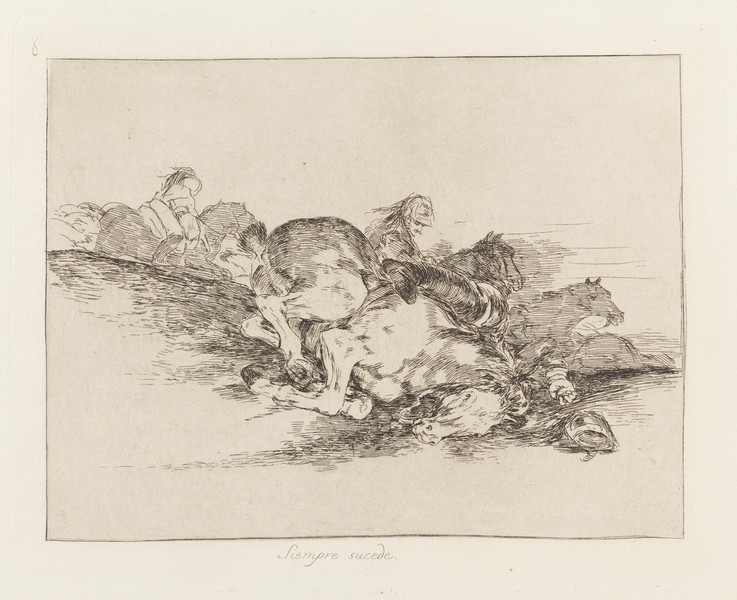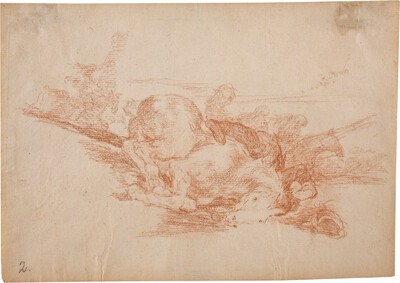- Cronología
- Ca. 1814 - 1820
- Dimensiones
- 177 x 219 mm
- Técnica y soporte
- Etching, aquatint and burin
- Reconocimiento de la autoría de Goya
- Undisputed work
- Ficha: realización/revisión
- 28 Nov 2010 / 24 May 2023
- Inventario
- 225
See Sad presentiments of what must come to pass.
There exist two state proofs of this print, one before the numbering and the drypoint work was added, and the other with the number etched on to the plate and some touches of light added in drypoint to the saddle of the horse, in the background on the left-hand side.
The title was handwritten by Goya on the first and only print run that we know to have been made at the time, and which the painter gave to his friend Agustín Ceán Bermúdez. The title was engraved on to the copperplate at a later date, and no other modifications were made to the image for the first edition of the Disasters of War, which was printed by the Royal Academy of Fine Arts of San Fernando, Madrid, in 1863.
There is a preparatory drawing in the Prado Museum
This always happens depicts either a charge or a retreat by dragoons of the French Imperial Guard. This was the name given to those soldiers who, from the second half of the 16th century to the beginning of the 19th, fought in the cavalry, normally on the offensive, and as defensive infantry.
In the foreground, Goya shows a fallen horse and its rider, who is largely hidden by the animal, with only one hand and a leg visible to the viewer. In the middle ground several other riders flee on horseback. It is likely that in this print the artist has created a generic representation of the way in which the French soldiers passed through the Spanish cities, since it seems that they did so at full gallop, using the element of surprise.
The action in the scene is concentrated in the centre of the composition, framed by the white of the untouched paper. The horses and their riders, galloping at great speed, have been rendered using etched horizontal lines, packed very tightly together. On the other hand, Goya has left large areas of white on the body of the fallen horse, drawing our eye to it. This is a dynamic, energetic image, thanks chiefly to the diagonal lines of the falling animal and rider and to the quick continuous horizontal strokes, somewhat longer than is usual in these prints, which have been used to depict the rest of the horses.
Eleanor Sayre has established a relationship between this etching and the prints belonging to the third part of the Disasters of War series, the Emphatic Caprices, by virtue of the way in which Goya works in these images. The horse shown here in This always happens displays strong similarities to the animal in print no. 78, He defends himself well. The two depictions represent the same animal in two utterly different postures: in the first print, the horse is falling helplessly; whilst in the second it has become an animal full of energy, lashing out and defending itself with virulence. Both animals occupy the centre of their respective compositions - a large white shape in the middle of each etching.
The present print is one of the most complex in the series and is difficult to connect to the others in this first part of the Disasters of War. It is just as challenging a task to make sense of the image using the title that Goya has given it. Perhaps it is a metaphor for the defeat that always comes in the end, inexorably, just when it is least expected, as symbolized here by the falling of the horse.
The etching plate is conserved in the National Chalcography Museum (cat. 259)
-
GoyaMinistry of Foreing AffairsBurdeos1951organized by the Bordeaux City Hall, consultant editor Gilberte Martin-Méry. From May 16th to June 30th 1951cat. 5
-
Goya and his timesThe Royal Academy of ArtsLondon1963cat. 66cat. 232
-
Francisco de GoyaMuseo d'Arte ModernaLugano1996exhibition celebrated from September 22nd to November 17th.cat. 8
-
Francisco Goya. Sein leben im spiegel der graphik. Fuendetodos 1746-1828 Bordeaux. 1746-1996Galerie KornfeldBern1996from November 21st 1996 to January 1997cat. 150
-
Goya's RealismStatens Museum for KunstCopenhagen2000from February 11th to May 7th 2000cat. 25
-
Francisco Goya. Capricci, follie e disastri della guerraSan Donato Milanese2000Opere grafiche della Fondazione Antonio Mazzottacat. 88
-
Goya. Opera graficaPinacoteca del Castello di San GiorgioLegnano2006exhibition celebrated from December 16th 2006 to April 1st 2007p. 55
-
Goya et la modernitéPinacothèque de ParisParís2013from October 11st 2013 to March 16th 2014cat.47
-
Goya, grabadorMadridBlass S.A.1918cat. 110
-
Goya engravings and lithographs, vol. I y II.OxfordBruno Cassirer1964cat. 128
-
Vie et ouvre de Francisco de GoyaParísOffice du livre1970cat. 1003
-
Catálogo de las estampas de Goya en la Biblioteca NacionalMadridMinisterio de Educación y Cultura, Biblioteca Nacional1996cat. 193
-
ParísPinacoteca de París2013p. 123
-
Goya. In the Norton Simon MuseumPasadenaNorton Simon Museum2016pp. 114-151

